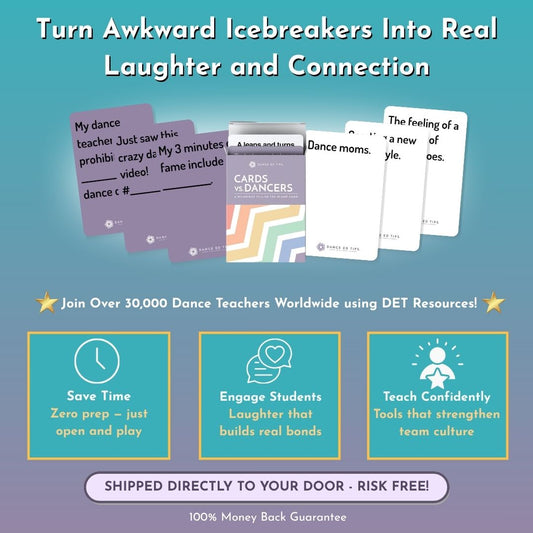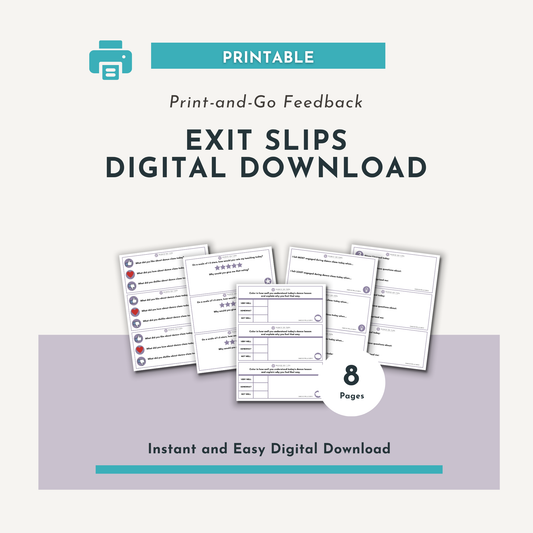So, you’re wondering how to become a dance teacher? You are ready to share your passion for dance with others, but you’re not sure where to start or how to begin. Depending on where you want to teach - in a studio, in PK-12 school, or in a university - each requires a different journey and qualifications.
In this guide, we’ll break down how to become a dance educator in each sector and provide helpful hints on things to consider. We at Dance Ed Tips have helped thousands of dance teachers in all stages of their careers become better dance educators through our resources, ongoing education, and membership and we know we can do the same for you! Let’s get started!

What do you need to become a dance teacher?
In order to be a dance teacher you need to have two types of knowledge: content knowledge and pedagogical knowledge.
Content knowledge is knowledge about the thing that you are teaching. In this case, it’s dance. As a dance teacher you should know the movement practices, the terminology, the cultural and historical context, and the anatomical function of the dance style you are teaching.
Pedagogical knowledge is knowledge about how to teach. This means understanding how people learn at various developmental stages and being able to implement strategies that help them gain skills and understanding.
When teaching dance both these worlds come together to form Pedagogical Content Knowledge: this is specific educational strategies to teach a particular content area. For us, it’s becoming experts on how to teach dance specifically.
No matter where you teach dance (a studio, a PK-12 school, or a university) you will need to have pedagogical content knowledge, but the qualifications, degrees, and work experience you have will also determine which kind of jobs you can apply for.
In addition to this, dance teachers are expected to:
- Teach and perform a variety of dance styles
- Create sequential and developmentally-appropriate lesson plans in those dance styles
- Choreograph in those dance styles
- Guide students safely through a warm up, conditioning, stretching, exercises, choreography and cool down
- Provide historical, cultural, artistic, and pedagogical context to their dance teaching
- Put on a performance with music, costumes, and lighting
- Implement classroom management strategies
- Differentiate their teaching for varying learners’ needs
- Create an emotionally safe space where students can grow and learn
- Continue their own education
- And much more

What qualifications are needed to become a dance teacher?
Well, it depends.

How to become a studio dance teacher
To become a studio dance teacher, there are no formal qualifications or requirements. It is up to the studio owner to evaluate your dance teaching skills and decide if you are a right fit for their school. For the most part, studio owners look for individuals that can demonstrate and teach movement well, have experience teaching, and can choreograph for class and performances. You can set yourself apart by being able to teach a variety of dance styles to students of varying ages, or some unique classes like choreography, mindfulness for dancers or conditioning. Being able to teach different types of dance classes allows the studio owner to give you a full schedule where you can teach several hours in a row. They might also be looking for someone who specializes in early childhood dance to teach the little ones . Although different studios might be looking for different things in a dance teacher, there are no formal qualifications for any of these positions. As long as the studio owner thinks you are qualified to teach after reading your resume, then you can teach dance.

How to become a PK-12 Dance Teacher
To become a PK-12 dance teacher in a school, you usually need to have a bachelor’s degree in dance and also a teaching certificate in your state. Some states or school districts even require that you get your master’s degree within a certain amount of time that you are hired. (I’m looking at you New York!) There are many undergraduate and graduate level university programs in the United States that will help you get the degree and certificate that you need to become a dance educator. University dance teacher preparation programs are a great option because they provide you a holistic education where you will grow in your content knowledge, pedagogical knowledge, and pedagogical content knowledge. This means you’ll not only learn about dance, but you’ll also learn about:
- Theory & philosophy of dance education
- The Dance Standards
- How to write a dance curriculum
- How to create lesson plans and assessments
- Technology tools for dance teachers
- Culturally relevant and responsible teaching strategies
- How to teach students with diverse learning needs
- Classroom management
You are also required to do:
- Observations of dance educators in the field
- A student teaching placement where you shadow a full-time PK-12 dance educators
When picking a university program make sure to look at what courses they are requiring for completion of the degree and make sure that these topics are being covered. But the bottom line is to teach in a PK-12 school you need a degree with a certain amount of credits in the field that you’re going to teach, which is dance, and you also need a certificate in your state that allows you to teach there.

Alternate paths in Pk-12 Dance Education
Now, there is a way to start teaching in public schools WITHOUT a teaching certificate and that way is called alternate route. (Some states have a different name for it. You’ll have to check to see what it’s called near you.) Many people don’t know about this option. It doesn’t apply to everyone, but I know quite a few dance educators who have been hired this way.
Alternate route is designed for professionals who’ve had an extensive career (10-20 years) as a professional dancer, choreographer, and/or teacher and want to transition into the PK-12 teaching profession. In order to go alternate route, a public school must first hire you based off your work experience. You must get offered the job first WITHOUT the teaching certificate, which can be challenging. Then, your school will register you to the state as an alternate route teacher. This means that you must earn your teaching certificate as you work in that school for the first year. You will most likely be required to have a mentor at your school and will have to attend additional classes outside of your work day to learn about the teaching side of the job. In these classes, they’ll cover more of the pedagogical knowledge to help you understand how to write a curriculum, write lesson plans, grade assessments and more. Once you have finished your first year of teaching and completed all the state’s requirements you will officially have a teaching certificate and will be able to apply to other jobs as a certified teacher instead of an alternate route teacher. These requirements for alternate route are different depending where you live, so be sure to check on your state’s website to understand the full scope.
Now, I do want to say that most schools look for dance teachers who are already certified, which is why most dance teachers attend a university teacher training program. Going through the alternate route process is more work for the school hiring you and they don’t always want to deal with it, but I still know of quite a few schools and dance teachers who have been hired this way, so it’s definitely possible.
The final thing we want to mention when it comes to being a PK-12 teacher is private schools. Private schools have more flexibility on who they hire, because they don’t have to follow the same state requirements as public schools. Some private schools require all their teachers to have a teaching certificate. Others do not. I know of several dance teachers who have been hired based on their professional work experience, so it is an option if you do not have a teaching certificate; however, we must warn you that private school dance teaching jobs are rare and competitive.
Overall, doing a dance teacher preparation program where you will earn a dance education teaching certificate in your state will make it easier for you to apply to jobs and become a PK-12 dance teacher. It does require an investment in your own education, but in my experience as the former Director of Dance Education at Hofstra University, dance teachers are often feel more prepared to meet the different demands of a PK-12 setting if they’ve completed a dance educator preparation training program.

How to become a dance professor
Finally, we come to being a college dance professor in higher education. Dance professors are experts in our field who are sharing their knowledge, methodologies, and artistry at a collegiate level. Most universities look to hire professors who have a Doctoral or Masters degree in dance or a closely related field. They also look for individuals who engage in scholarly dance work including:
- Creating, performing, and/or sharing choreographic work
- Dancing and performing professionally
- Conducting research in the dance and dance education field
- Publishing findings and best practices in dance and dance education journals
- Presenting on dance and dance education at regional, national, and international conferences
- Being a leader in national dance and dance education organizations and committees
- And more
The application process for university positions is rigorous and competitive. Many universities ask for applicants to submit a Curriculum Vitae, cover letter, research statement, teaching philosophy, diversity and inclusion statement, sample syllabus and much more. Lastly, if selected as a candidate be ready to teach a sample lesson and to be interviewed by faculty and students.
A great way to begin your journey to becoming a full-time dance professor is to begin as an adjunct, or a part-time professor. This will get you some experience teaching in higher education, help you build a network in this sector, and will be a good addition to your resume.

What are you expected to teach as a dance educator?
Depending on your teaching setting, what you are expected to teach changes. We have many dance teachers who transition from being a studio dance teacher to a PK-12 dance teacher or a PK-12 dance teacher to higher education that feel this big shift in what is being asked of them.
When you teach in a dance studio, your main focus usually is teaching technique. Your primary job is to teach people how to dance. Most dance studios do not require you to teach dance history, anatomy, choreography, or improvisation, although many studio dance teachers do include this on their own.
When you teach dance in a PK-12 school you are expected to follow your state’s dance standards and/or the national dance standards . What are dance standards? They are benchmarks of skills and knowledge that dancers are expected to reach by certain grade levels. This means that you, as the dance teacher, are expected to teach the standards so that your students can achieve these milestones. The standards are broken into 4 artistic processes: perform, create, respond, and connect. All of the teaching materials we offer can be filtered and searched for by these artistic processes.
Most teachers who transition from being a studio teacher to a Pk-12 teacher, feel comfortable meeting the “performing” standards, but are new to teaching how to create, respond, and connect in dance. Using materials and resources that are focused on these artistic processes are a great way to get more comfortable teaching these concepts. You also might want to consider taking some professional development courses to help you get ideas on how to teach these concepts in a way that is appropriate for various age groups.
As Pk-12 dance teacher you will be required to teach:
- Technique
- Dance history
- Choreography
- Improvisation
- Anatomical principles
- Responding to dance through writing, speaking, and moving
- Connecting ideas in dance and outside of dance
You will also be required to create and administer formal assessments (diagnostic, formative, and summative) in order to show growth in dance. In studios, most dance teachers are not asked to quantify their students’ learning in this way; however, in a PK-12 school you will be expected to give assignments and grades to all students.
As a dance professor, what you are expected to teach is often outlined in the job posting. Depending on the position, some positions might ask that you are an expert in certain dance styles or cultural dance forms or ask that you are qualified to teach specialized courses like: dance history, anatomy, improvisation, choreography, etc. Although this might be written in the job description, your actual course load for each semester might change or vary depending on the changing needs of the department. You might also be asked to mentor students through an independent study, senior practicum, or choreographic process along with being part of a variety of committees within and outside of the dance department. Some universities also require full-time professors to act as advisors who help students with registering for classes each semester. If you are interviewing for a university position, be sure to ask what other requirements will be asked of you in addition to teaching classes. This will help you gauge the full scope of the position so you won’t be surprised later.
In closing
If you’re reading all this and thinking “Being a dance teacher is a lot of work,” that’s great! Dance education as a profession, calling, or job is often underappreciated and much of the work that goes on behind the scenes is unrecognized. Unfortunately, many individuals believe that just because they are a talented dancer that automatically makes them a great dance teacher and that just isn’t true. Teaching dance in all settings requires a commitment and understanding of dance as an artform AND commitment and understanding of how people learn.





